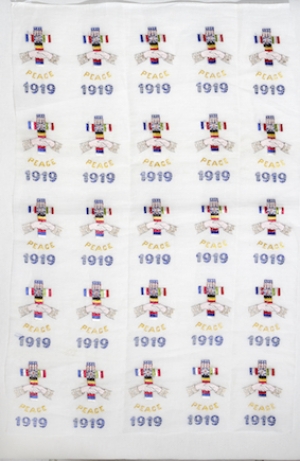Embroidered silk postcards were especially favoured during and just after the First World War (1914-1918). During the war, the range of designs worked was varied and included obviously military subjects, such as the flags of the allies (notably Belgium, Britain, Croatia, France, Italy, Portugal, Russia, and the USA), names of regiments, figures of famous generals, and more public subjects such as Christmas, birthdays and New Year best wishes. In addition, many cards carried illustrations of butterflies and flowers, as gentler, more sympathetic images. Comparable cards were made in Germany, but with different designs and texts.
The designs and texts were worked in small, silk gauze panels with colourful, free style embroidery. A wide range of stitches were used, including the back stitch, basket weave stitch, individual cross stitches, herringbone stitch, reverse herringbone stitch (to create a shadow work effect), double running stitch (Holbein stitch), satin stitch, stem stitch, as well as various composite stitches. These embroidered panels were then stuck to a card frame embossed with a decorative edging.
In the past, various questions have been raised about these cards, especially as to how the cards were decorated, and by whom. There are several possible answers. It has been suggested that the images were hand embroidered by Belgian and French women who had been afflicted by the war. But would they have really been able to hand embroider millions of cards? Another explanation, and far more likely, is that they were machine made, but this brings us to the question, which type of machine was used?
A machine that could imitate the appearance of these hand stitches is the Hand-Embroidery Machine that was invented in 1828 by Josué Heilmann (1796-1848) in Mulhouse, France. In 1835, technical drawings of his machine were published. The machine was further developed over the following decades by various engineers and companies in Britain, France, Germany and Switzerland. Basically, this hand-embroidery machine used a pantograph system to transfer the stitches. Each stitch is drawn out on a large scale design and then its position traced by an operator using a point on one arm of the pantograph. A series of needles responds to the movement of the pantograph arm. Each needle has an eye in the middle for the thread, and two sharp ends. The needle is passed backwards and forwards through the ground cloth using a pincer system (double-sided pincer wagons), so imitating the action and appearance of hand embroidery. Each colour in the design is individually stitched (so all the blue parts, for example, are worked, and then the machine is re-threaded with a new colour), until the design is complete. This machine, in various sizes, was used in both domestic and factory settings.
Based on surviving examples, it would appear that wide strips (domestic production) and very broad sheets (factory production), both of organza cloth were embroidered. Using hand-embroidery machines it was possible to produce hundreds of images on a sheet in one go. An important detail in this respect is that none of the sheets or individual postcards so far examined show any indication of a drawn or printed design that would have been essential if the embroideries were being made by hand. However, if the hand-embroidery machines were being used, then the drawings were transferred directly to the rows of needles by use of a pantograph, so no drawing or printed outline was required.
Once embroidered, the strips/sheets were cut up and the individual images were stuck into an embossed card frame. They were then sold to the public, especially the soldiers, at a relatively high price. The companies making and selling these cards could well have made a considerable profit. Perhaps this is the real reason behind the stories of poor refugee women working all hours to hand embroider these cards in order to feed their desperate families.
The TRC has made a digital exhibition featuring and describing the silk postcards in the TRC collection. Please click here to view the exhibition.
Sources:
- COLLINS, Ian (2001). An Illustrated History of the Embroidered Silk Postcard, Radlett: Gabrian Antiques.
- STROBEL, Heino (2012). The Beginnings of Machine Embroidery in Saxony, available here (retrieved 25th October 2015).
Digital source (retrieved 21st May 2017).
Videos showing early hand-embroidery machines in use:
- http://youtu.be/g9n1CYs9MaM (retrieved 4th June 2016)
- http://youtu.be/a5ZYZsFnhNU (retrieved 4th June 2016)
- http://youtu.be/_vYCMz-M2zs (retrieved 4th June 2016)
TRC online catalogue (retrieved 21st May 2017).
GVE

